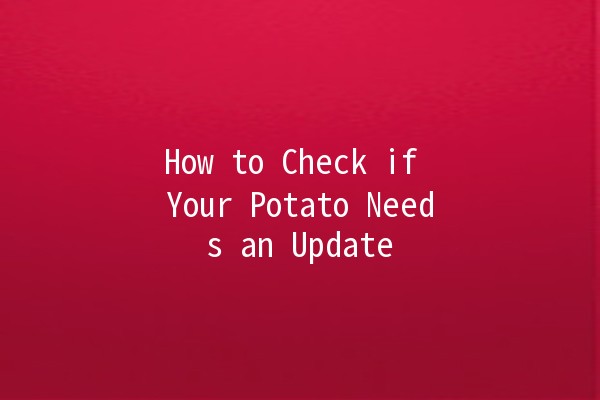In the realm of digital content, it’s essential to keep your materials uptodate and relevant. While "potato" might suggest a simple vegetable, in the world of technology and content management, it symbolizes an evolving entity that may require updates for improved performance, relevance, or appeal. This article delves into the intricacies of determining whether your potato—be it a digital asset, content piece, or product—needs a refreshing touch.
Understanding the Importance of Updates
Updates are more than just a cosmetic touchup; they are necessary for maintaining both user engagement and competitive relevance. As trends evolve, so too must our approach towards content and products. Not only do updates help enhance functionality, but they also ensure that the audience receives accurate and timely information. This is particularly true in fastpaced industries where information evolves incredibly quickly.
The Signs Your Potato Needs an Update

Identifying when an update is required can be nuanced. Here are some indicators that it might be time for a refresh:
Productivity Enhancement Tips
Explanation: Schedule periodic reviews of your content or products to evaluate their relevance and performance.
Implementation: Establish a content calendar that includes specific dates for reviewing and updating. For example, every quarter, assess your articles to see which are still performing well and which need refreshing.
Explanation: Leverage analytics tools like Google Analytics to gather data on user engagement and content performance.
Implementation: Set up tracking metrics that will give insights into click rates, session duration, and user demographics. Use this data to inform your updates and prioritize content that requires attention.
Explanation: Actively seeking user feedback can provide valuable insights into what needs updating.
Implementation: Create surveys or polls for your audience asking for their opinions on your content or products. The feedback collected can pinpoint which areas may require an update.
Explanation: Staying informed about industry changes can help you understand when updates are necessary.
Implementation: Subscribe to industry newsletters, join forums, and follow key influencers on social media. Regularly scan these resources for trending topics or changes in standards that could impact your content's relevance.
Explanation: Using a CMS can streamline the process of monitoring and updating your content.
Implementation: Choose a CMS that provides analytics and notifications about performance, allowing you to efficiently manage your content without needing manual oversight.
Frequently Asked Questions
It's advisable to review your content or product at least quarterly. However, if your industry evolves rapidly, you might want to consider a shorter review cycle.
Focus on metrics like bounce rate, average session duration, pages per session, and conversion rates. A drop in any of these can indicate that your content might need updating.
Absolutely! User feedback provides insight into how your audience perceives your content or product. Ignoring it can lead to a significant disconnect between what you offer and what users want.
While it’s crucial to focus on underperforming content, also consider reviewing highperforming content to ensure it remains relevant and updated with the latest information.
By following industry blogs, attending webinars, and participating in professional networks, you can remain informed about the latest trends that affect your content strategy.
Yes! Updating content often helps improve its SEO performance, as search engines favor fresh, relevant information. Updating can also enhance user engagement, which contributes positively to your rankings.
Keeping Your Potato Fresh
As we’ve gleaned from this discussion, continuously assessing your digital "potato" is essential for maintaining its health and effectiveness. Regular updates can significantly enhance user engagement, optimize SEO, and keep your brand relevant in an increasingly competitive landscape. Through consistent evaluation, user feedback, and trend awareness, you can ensure that your content or product remains appealing, functional, and informative.
By implementing these strategies, you can stay proactive about managing your digital assets and ensure that they are always in top form, much like a wellkept potato ready to make a perfect dish!